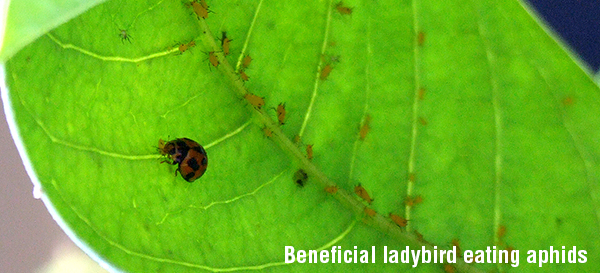|
How to control bad bugs while protecting good bugs
We love beneficial insects. Not only do they help control the bad bugs but many beneficial, like bees aid pollination to provide us with food we need and keep our eco system in balance.
Most pesticides and insecticides including many organic alternatives are non-selective and therefore may harm beneficial insects. Thoughtful consideration is paramount when controlling bad bugs to ensure the good bugs are protected.
Most of us are averse to spraying chemicals around our backyard gardens but in some cases, when we have exhausted all other alternatives, spraying is necessary. The good news is that most sprays on the market now are very low toxicity. Here are some tips to use pesticides and insecticides while letting our bees and other beneficial insects buzz freely to do their job.
- Bring in the good bugs and animals. Select plants that bring in the beneficial insects, birds and reptiles (Guardians of the garden article). Beneficial insects such as ladybugs eat aphids. Beneficial insects are attracted to native vegetation for food and shelter. This vegetation provides shelter for reptiles and nesting for predatory birds so you will have a whole army at the ready to control the bad bugs. Consider planting more Australian native plants and trees of different heights and structures to provide a home for beneficial animals for all areas of the garden.
- Consider using an insect proof mesh cover over your edible plants. These covers can be used when needing to provide protection from chewing insects and left open when you need to allow pollinating insects access to the plants. Google search “vegetable garden insect netting” for options.
- When using sprays, avoid spraying at the time of flowering and fruiting or in areas where bees are collecting pollen from flower heads.
- Spray early evening when the bees are not active and have gone back to the hive.
- Select more modern plant breeds that have been bred to be more resistant to pests & diseases.
- Be vigilant, spray early. Early detection of bad bugs and immediate control will result in less spray use. You may only need to spray a small area of the affected plant and not the whole plant or crop.
- Generally, pesticides are fine to use for indoor plants as many beneficial insects aren’t common indoors so spraying can take place.
- Before using herbicides on lawns, mow the grass to remove all flowering seed heads. This acts as a twofold solution. Firstly, it removes the flowers that the bees may access for pollination so that when you spray bees won’t be present and secondly it will stop the weeds from setting new seeds. After mowing the grass wait a few days for new growth to activate but don’t allow the seed heads to reappear before spraying. Use a wetting agent such as Searles Spredmax to maximise the coverage contact of the herbicide. Larger weeds can be removed by hand.
- Healthy plants with healthy soils are more resistant to pests and diseases. Choose plants which are well suited for your climate and soil type. Maintain your plants soil health and follow the plants recommended water requirements.
- Let it Bee! Sometimes if the insect damage is not severe let it be and see if nature provides the solution. In many cases beneficial insects will come to the rescue in time and if the leaves and flowers have a few chew marks on them that is perfectly natural. Perfection in plant appearance is very challenging to maintain and is generally not a balanced approach to gardening with nature.
|
|
|






